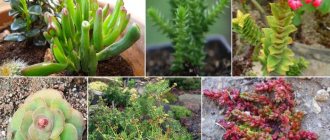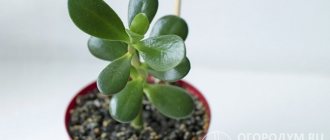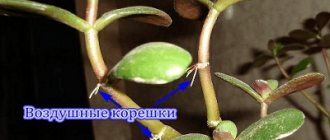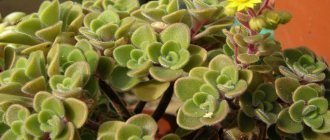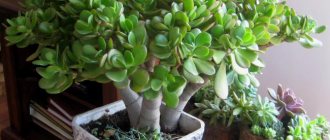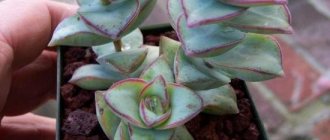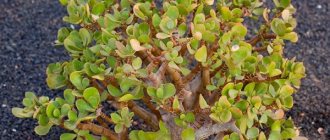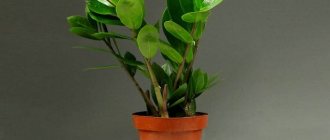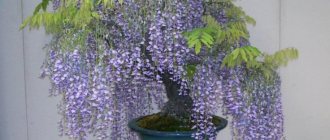Succulent lovers are sure to have at least one representative of the Crassula species in their collection. An unpretentious money tree is an elegant interior decoration. With proper care, Crassula will resemble a real tree with round coin-shaped leaves. There is a belief that a large money tree attracts wealth and prosperity to the house. Grown from a sprout, it can improve the home environment, bring not only aesthetic pleasure, but also be useful in the treatment of many diseases.
About the plant
The indoor perennial comes from the countries of the Southern Hemisphere, so it prefers the sunny side and dry soil. Watering, of course, is necessary, but at large intervals. In order for the tree to start working and bring wealth to its owner, it should be placed in the apartment according to Feng Shui - near the south, south-east window opening. The financial situation of the family will depend on how green and fleshy the leaves are.
The deciduous ornamental plant belongs to the genus of succulents. It tolerates drought well, thanks to the special structure of the leaves - they accumulate moisture. At home, a coin tree can grow up to 2 meters. In nature there are 4-meter specimens.
Most fatworts are perennials, but annual species are also found. They die immediately after flowering. To see the money tree bloom, you will need to work hard and be patient. Delicate white flowers will only appear if the plant is kept in the right conditions.
Crown formation
If you properly care for the money tree, but do not prune it, the plant will never be as beautiful as in the photo in glossy magazines. In an adult fat plant, the shoots will begin to bend and stretch, the leaves will fall off prematurely, and the crown will become asymmetrical. Caring for the plant will be more difficult; you may miss the first signs of diseases or pests.
It is easy to make a fat plant look like a bonsai without making Herculean efforts and without shortening the root:
- The crown of the young plant is pinched.
- In emerging side shoots, except for the lower ones, the growing point is regularly removed, even during the dormant period.
- The twigs and leaves located at the base of the fat plant are protected - they are needed to thicken (expand) the trunk.
- When the flower becomes large, tops will appear. They are removed everywhere except the bottom.
- Thick shoots at the base are first shortened and then gradually removed, replacing them with tops. Large cuts will heal quickly and become invisible over time.
- When the trunk reaches the desired diameter, it is lightened - the lower branches, leaves, and tops are removed.
- Transplant the fat plant into a low, wide bowl. The roots do not need to be trimmed.
Compared to a real bonsai, this plant is much easier to care for. It is less capricious, more resistant to adverse factors, and looks no worse. Especially when the owners get used to it and show their imagination.
The good thing about Crassula is that even an old, ugly specimen can be easily put in order. The crop tolerates a short haircut, when the crown is cut off, a bare column is left. If the operation is carried out in the spring, tops will quickly appear, and already in the next season the flower will regain its attractiveness.
When the owners do not want to do drastic pruning of the fat plant, well-placed branches can be left. To cope with a dense crown, you should follow the rule: select shoots that do not need to be removed, but those that definitely need to be preserved. Then the work will go faster.
Types of money tree
In total there are about 300 species of coin trees. Many specimens take root well not only in special greenhouses, but also in simple apartment conditions. Tree-like, ground-cover, spike-shaped, decorative-flowering species of Crassula are designed for indoor keeping.
“Money tree” belongs to the tree-like plant species. This group includes the usual fat plants, which have a characteristic woody trunk and dense leaves. Some specimens may look radically different from each other and have different descriptions. In turn, they are divided into the following varieties:
- Ovata. Also called “Coin Tree”, “Bear’s Ear”. The maximum height of the tree is 2 m, the thickness of the trunk is 30 cm. The leaves are bright emerald green and elliptical in shape, small in size. Some varieties of Ovata have a red border around the perimeter of the leaves. The plant blooms white, the inflorescences are collected in the form of umbrellas. It is easy to form a bonsai or branched composition from such a money tree.
- Ovata Minor. Representatives of the species have a beautiful, non-trivial shape. The miniature plant barely reaches a height of 20 cm with a maximum trunk width of 2 cm. The interesting color of green leaves with a scarlet tint makes the plant ideal for creating home compositions.
- Ovata Sunset. It stands out with its expressive red-yellow-white painting on the leaves. A beautiful hybrid must always be kept in a place with plenty of natural light. Otherwise, the leaves of the plant will lose their unique color.
- Oblikva. The leaves of this species are oval with a pointed tip. The leaf blade is large with a raised end and downward curved sides.
- The Hobbit. The hybrid was created by breeders by crossing common toast with milkweed. The result is leaves turned outward, connected from the base to the middle. The trunk is more branched than that of simple Ovata. The perennial Hobbit has several variegated varieties called Golum, Chimera and others.
- Undulatifolia. A non-standard variety of Crassula stands out for its silver-blue flat leaves. The tips are slightly wrinkled and have a reddish tint.
Photos of Crassula pellucida
Crassula ovata (crassula ovata)
This species is so named because its leaf blades are oval in shape but rounded at the end. They reach a length of 30-90 mm. A red stripe often runs along the edge of the leaf blade.
Crassula portulacea, or silver crassula
This species is similar in appearance to egg thistle. The glossy leaf blades are teardrop-shaped. After some time, the branches diverge in different directions. The number of leaf blades on the branches is very large, and they form a very lush crown.
Crassula Hobbit
This species differs from others in the shape of its leaf blades. The shape can be different, but most often it is pointed.
This plant also has other differences from other types of Crassula, for example: the bush blooms very rarely in indoor conditions and is characterized by slow growth (annual growth is only a few centimeters).
Crassula sunset
This species is distinguished by the color of its leaf blades. Red stripes are clearly visible along the edges of the leaves. Compared to the oval subspecies, they are much larger. Under special lighting, the plant may appear as if it is on fire.
Crassula arborescens
This species, unlike others, can grow into a really large tree over the years. However, it requires proper care and the most favorable growing conditions.
Crassula tetragona
The leaves of this species also have an unusual, broadly spherical shape. The leaves reach a length of about 40 mm. Woody stems.
Crassula pellucida
The foliage has an unusual color. There are dark pink stripes along the edges.
Thickensia tetraphy (Crassula lycopodioides)
Thickensia tetraphy (Crassula lycopodioides)
This species is similar in appearance to the tetrahedral species. Apart from the unusual shape of the leaf blades, this species does not have a distinct woody stem.
Tips and rules for growing and caring for plants
Most often, flower growers grow the Ovata species of Crassula on their windowsills. An unpretentious money tree with a thick trunk and oval leaves does not require special maintenance conditions. It is enough to remember his love for sunlight, take into account the period of growth and rest. If you choose the right pot, type of soil and fertilizing, you can get natural home decor with ideal characteristics.
Soil and pot size
You can determine whether the soil is chosen correctly for a money tree by the condition of its leaves. If they are bright green in color with red tips, dense and fleshy, then the soil is doing an excellent job of its nutritional function. In order for the fat plant to grow strong and bloom, it needs to create all the conditions for this.
Only loose soil with plenty of sand and drainage is suitable for the money tree. The breathable structure will prevent fluid stagnation. After watering, excess moisture should go into the pan and not remain in the soil.
Plant growth depends on the quality of the soil. For an underdeveloped root system, a special composition consisting of several layers will be required. The bottom layer of 1 cm is laid out with pebbles and broken bricks. In the middle there is a soil mixture of soil, river sand, and humus. The top is covered with expanded clay.
The root system of the Crassula plant will develop well in a wide, shallow pot. The width should be at least 1.5 times the crown diameter. The container must be stable with a flat bottom to prevent the plant from overweighting and tipping over. The size of the money tree depends on the depth of the pot. If you plant it in a long flowerpot, it will stretch upward; in a low flowerpot, natural branching of the plant will occur.
To plant a money tree, you cannot use mixtures based on peat or moss. Such soil retains moisture for a long time, which will lead to rotting of the plant roots.
Temperature
The usual room temperature of 20-25° C is suitable for Crassula. The minimum threshold is 10° C, the maximum is 32° C. In summer, the pot can be taken out to the balcony or veranda. To lower the temperature, the fat plant can be moved to the floor. If the temperature goes beyond the comfortable limits for the plant, the flower goes into a state of complete freezing.
In winter, it is better to move the money tree to a cool place. The temperature should be maintained in the range of 14-16 ° C. The fat woman can winter on the loggia, on the northern windowsill. The condition of the plant must be constantly monitored in order to notice changes for the worse in time.
Air humidity
Coinwood does not require moisture control. Dry room air in summer does not harm it. The plant calmly sprouts shoots and grows leaves. Once a month it can be sprayed with a spray bottle or doused with water from the shower. In the latter case, it is necessary to cover the ground with polyethylene.
All types of succulents are accustomed to low humidity. Plants with high moisture requirements are not suitable for them as neighbors on the windowsill. Do-it-yourself removal of dust and dirt from the leaves should be done with a damp cloth.
Lighting
The ideal place for representatives of succulents is a windowsill. It is better if the windows face south, southeast. On the southern window, the plants will have to be shaded when the sun is at its zenith. The north side is not taboo for the Crassula. But, the money tree will begin to grow upward, branching will stop, and the stems will become weak and stop becoming woody.
For such plants, lighting plays the most significant role. With a lack of light, Crassula can completely stop growing, get sick and even die. In the summer, in addition to light, the plant has a need for fresh air. If it is not possible to take the pot outside, the room should be periodically ventilated, taking care of it without drafts.
Watering
The money tree categorically does not like excessive moisture. Excess moisture will lead to rotting of the roots, trunk, and branches. After which the plant will no longer be able to be saved. If the soil is constantly wet, fungal diseases will develop and the leaves will turn yellow and fall off.
Due to the constant accumulation of moisture in the leaves, excessive watering poses a greater danger to Crassula than its lack. Such a plant will delight those who constantly forget to water it with a lush and green crown. Crassula grows freely without water for a month. Recommended watering schedule: in summer - once a week, with the onset of cold weather - once every two weeks.
Feeding and fertilizer
The application of fertilizers is necessary for the plant at all stages of growth, especially after transplantation. Special fertilizer is included in the soil for certain types of plants. It is recommended to plant the money tree in a mixture of soils for succulents and ficus. As the nutrients originally contained in the soil become depleted, they will need to be replenished. The fertilizer that is suitable for the fat plant is the same as for cacti.
You need to start feeding in early spring. It is easy to determine the appropriate period. As soon as pairs of leaves appear, it means it’s time to increase the activity of the growing season. The soil is supplied with mineral fertilizers once a month. You can carry out the procedure more often, but then you need to reduce the amount of nutrients.
Fertilizers in granular form are applied to moist soil and mixed. This is done to avoid causing burns to the roots. The dry matter will break down slowly and will not reach the roots too quickly. Active feeding should not be prolonged.
Crown formation
Due to branching shoots and their strong growth during the growing season, the plant may lose its decorative appearance. The formation of the crown will help restore its former attractiveness. In addition to increasing decorativeness, pruning is carried out to improve color stability, simulate a strong trunk, and facilitate the care of succulents. There are several crown formation schemes:
- To strengthen the central trunk. In young fat plants, branching shoots and foliage in the lower part are removed. At the time of applying fertilizer, all newly formed branches are removed from an aged tree.
- Hanging shoots from the tops. The formation of a bonsai-type crown can be carried out after strengthening the trunk. Otherwise, the flimsy base may not withstand the load.
- Low, compact bush. You can stop the stretching and add splendor and volume if you regularly tear off the leaves on the trunk. Temporarily stopping watering will help slow growth.
- Spreading shrub. The money tree will increase in width if you constantly pinch the shoots at the top of the bush. Removing shoots from the apical buds will provoke branching of shoots from the axils below the cut.
Transfer
The best time to plant Crassula in new soil is the first half of March. During its development, the plant will more easily tolerate changing soil and pot. In summer and autumn, Crassula is replanted if absolutely necessary, if the container is not suitable in size, diseases or pests are detected.
According to the rules of replanting, all plants need to change the soil and pot every year. Flowers 3 years old and older should change their habitat once every two years. Frequent transplants of the fat woman are contraindicated. Each event is stressful for the tree and requires a lot of time to adapt and recover. Excessive movements can damage fragile leaves. To make money, an adult plant is replanted according to the following step-by-step scheme:
- Clean the new pot, prepare a mixture of soil, drainage, humus;
- Place crushed stone and broken bricks on the bottom of the flowerpot;
- Cover the substrate with fresh soil;
- Make small holes around the trunk, loosen the tree and remove it from the old pot;
- The soil at the base is not removed; only dead, rotten roots can be removed;
- Lubricate the cut areas with wood ash;
- Leave the plant to dry for several hours;
- Place the money tree in the center of the new container;
- Add soil to the root collar and water generously;
If, during the process of transplanting a fat plant, rotten roots are discovered, for the purpose of resuscitation, the plant is planted in a mixture of sand, turf and humus.
Bloom
Seeing a money tree strewn with white inflorescences is a great success. This plant does not often please with color, since it grows slowly and requires special conditions for the appearance of buds. If this event occurs, then the owner of the Crassula will be pleased with small white flowers, similar to stars, that appear on some or all of the young shoots.
Crassula can bloom at any time of the year. More often this happens in autumn or winter. If this moment does not occur for a long time, the reasons for the lack of bud formation should be found. The money tree will not bloom under the influence of the following factors:
- The plant is constantly exposed to light;
- The soil is dense and acidic;
- The earth is constantly moist;
- Stems and leaves are damaged by pests;
- The bush is affected by fungus and other diseases.
Where is it better to place it in an apartment?
The money tree loves light and fresh air. If in the summer it is possible to put it on a balcony or at least on a loggia, even a glazed one, so that the windows open regularly and fresh air comes in, then this will be ideal.
It is best if the money tree stands in a place where the sun's rays fall on it in the morning - when the sun is not yet too active, and in the afternoon there is already partial shade. If the sun shines constantly, the leaves will begin to turn red. In order for the leaves to be bright green, you should avoid this.
Reproduction methods
Crassula can be propagated in several ways. The choice of the appropriate option depends on the goal and expectations of the grower. Each method has its own characteristics, and therefore requires a clear definition and detailed explanation of the actions.
Cuttings and leaves
The easiest way to divide a money tree, especially if you need to preserve all the characteristics of the variety. Using cuttings, you can quickly grow a young but already grown plant at home. Propagation material can be taken at any time of the year. Young shoots remaining after the formation of the crown, small shoots that have taken root from the leaf, will take root well.
Only healthy, well-developed shoots can be cuttings for propagation. Curved, thin branches are not suitable, since the growing tree will take the same shape. A cutting of 5-10 cm, with at least 3 nodes and 3 pairs of leaves, is considered good material. Cut it from the top or from the stem. For rooting, part of the plant is placed in water. No special treatment is required to speed up the process.
Removing a money tree from a leaf is a long process, but real. The roots form quickly, which cannot be said about the sprout itself. A dense green leaf is suitable for dividing in this way. It is better to remove material from the middle of the branch. After cutting, the leaf is placed in water or directly in the ground. It should simply be on the surface in a horizontal position. The base of the sheet should be immersed in the substance by 5 mm.
Seeds
Reproduction by seed material is rarely carried out. This is due to the long process of plant formation and large time and labor costs. This method is used by breeders to grow new varieties and hybrids. At home, planting and caring for money tree seeds is carried out as follows:
- Small containers are well washed and disinfected;
- Fill them with soil mixture;
- Seeds are poured onto the surface of the leafy soil and sprinkled with sand;
- Spray with water from a spray bottle and cover with glass or film;
- After 2-3 weeks, the first shoots appear;
- For seedlings, other pots with turf-leaf soil are prepared;
- When the plants grow to 5 cm, they are transferred to light soil and placed in a place with a constant temperature of 15-18 ° C.
Possible problems
When growing a home money tree, a gardener may encounter the following problems:
Leaves fall in winter. The room is excessively hot. However, if leaves fall at other times of the year, this may also be due to stagnation of water, which leads to rotting of the roots. It can also be caused by high nutrient levels in the soil. Shoots and leaves become thinner. The bush is over-watered. Rot has appeared on the root system. The substrate was moistened too often and abundantly during the dormant period. Yellowing of leaves. Overexcitation from exposure to light. Leaf blades wither. Too much light. Light-colored spots appear on the leaves. These are sunburns. They usually appear when the bush is exposed to direct sunlight for too long. Black spots form on the leaves. It can also be sunburn, but not always. This may also be a sign of a fungal disease, which often begins to develop due to excessive watering or infrequent ventilation of the room. If the spots are dry and brown, this is due to a lack of moisture. A pale red dry crust appears on the surface of the leaf blades. This may be caused by the bush being exposed to direct sunlight, lack of fresh air, or a lack of nutrients in the soil.
Diseases and pests
The main factors leading to diseases and pests in Crassula are dampness and drafts. The reason for the development of all negative events is improper care. The most dangerous period for fatworts is winter. Ailments appear at this time due to lack of lighting, temperature fluctuations, and the operation of heating devices. With insufficient attention, the plant may suffer from the following diseases and pests:
- Fungal diseases. Defeat by spores occurs in the cold season. Gray, wet rot appears as brown spots, constantly increases and spreads over the entire leaf. Treatment consists of transplanting the plant into disinfected soil and removing diseased shoots. Fungal spores will be eliminated by reducing the amount of watering, ventilating the room, and disinfecting sections with a solution of potassium permanganate.
- Bacterial diseases. Externally they resemble a fungus. Such diseases are treated with fungicides. Then it is necessary to spray with products based on penicillin and gentamicin so that the leaves do not begin to fall off.
- Shield. Female insects attach themselves to leaves and stems and remain motionless. All affected areas must be smeared with kerosene and pests must be removed manually. Then the entire fatty must be treated with a solution of laundry soap and tobacco.
- Spider mite. The appearance of an insect is indicated by a silvery coating on the stems and leaves. Inaction leads to yellowing of the plate and its death. A sharp rise in humidity levels will help remove the pest. The tick does not live in such conditions. The money tree should be sprayed generously with water and placed in a plastic bag.
- Mealyworm. It lives in the axils of leaves, feeding on their juice and plant tissues. This leads to a weakening of the fat woman’s immunity and shedding of leaves. Remove the insect with a stream of water. The pest's habitats are wiped with a cotton swab dipped in garlic infusion.
- Root mealybug. The pest can only be detected when the plant is replanted. The roots will be covered with growths, and insect movements will be noticeable. Until then, the reason for the deterioration of the fat woman’s condition will be unknown. The worms are removed under warm running water and treated with pesticides.
Name and botanical description
A succulent from the Crassulaceae family is called a money tree. Its Latin name is Crassula.
In everyday life, the house flower was given other names:
- penny tree;
- Crassula;
- coin tree;
- dollar tree (although this name is more typical for Zamioculcas);
- bear ear;
- the tree of Life;
- tree of luck.
This succulent is native to South Africa. There are many types and varieties of plants that differ greatly in appearance.
At home, the tree-like crassula is most often bred, which was given the name money tree for the shape of its leaves.
Tree Crassula looks like a tree with a thick gray-green trunk. As the succulent plant matures, the trunk becomes woody.
Money tree leaves are dark green or silver. The plates may have a red edge and are sometimes covered in spots. The surface of the leaves is glossy. They are shaped like coins. The size of one sheet is 4-7 cm.
The money tree indoor plant can reach 1.5 m. If desired, it can be trimmed so that the height does not exceed 50 cm.
Crassula is a slow-growing succulent. It reaches its maximum size only in the tenth year of life.
Popular varieties of tree crassula:
- Ovata;
- Purslane;
- Silver;
- Minor.
Also at home you can find columnar and ground cover (creeping) species of representatives of the Tolstyankov family. The first of them includes such a variety as Plaunovidnaya, the second - Perforata.
Healing properties of money tree
Many herbalists highly value the medicinal properties of Crassula. The money tree can have a positive effect on a person’s emotional and physical health. The plant has antiviral, healing, antiseptic properties. It also relieves itching, relieves pain, and softens the skin. Crassula is included in various traditional medicine recipes.
For skin and hair
Money tree is successfully used in cosmetology. Thanks to its amazing healing properties, the plant is in demand in the beauty industry. Crassula is a raw material for the production of hair, hand and face skin care products.
Crassula face masks have a rejuvenating, cleansing, and soothing effect. A universal remedy can get rid of acne and saturate the dermis with useful substances. To do this, you need to cut several leaves, cut them lengthwise, and wait for the juice to release. The area of the break should be lubricated with foci of inflammation.
Crassula has an amazing effect on hair. They begin to grow faster, strengthen, become firm and elastic. The mouthwash is prepared from the succulent green leaves. A small amount of raw materials (5-10 pieces) must be washed, placed in a glass container and poured with 1 liter of boiling water. The infusion is left in a dark place until it cools. It is then filtered and used to rinse hair.
For joints and blood vessels
The juice of all succulents has an anti-inflammatory effect. It is often used in the complex treatment of joint diseases. It quickly relieves symptoms of arthritis, sprains, and rheumatism. To make a miraculous lotion, you will need to pick a bunch of money tree leaves and grind them. Place this mixture on gauze and cover the affected area. The compress should be secured with a bandage or soft cloth and left for 2 hours.
Crassula is used to treat a wide range of diseases. One of them is varicose veins. An alcohol tincture is prepared from the plant, which relieves swelling and relieves pain. Medicine is prepared from Crassula leaves. Fill them with alcohol and leave for 1 month in a dark place. Wet your hands with this product and massage your feet with benefit.
For mucous membranes
Money tree drops quickly relieve a runny nose. Prepare the solution one time at a time. You need to squeeze out the juice of one leaf, mix it with water 1:1 and drop it into both nostrils. If you have a persistent runny nose, you can prepare a medicine for rinsing. We extract the juice from 10 leaves, filter through gauze, mix with water and use for rinsing.
Crassula rinse solution will be an excellent assistant in the treatment of sore throat. The plant can be used for stomach ulcers and to restore damaged tissue. To relieve inflammation and reduce pain, it is enough to eat 2 leaves of crassula in the morning an hour before meals.
Brief description of cultivation
Money tree (crassula)
Temperature regulation. In summer it grows well at room temperature (not higher than 27 degrees). During the winter months, keep the bush in a cool place (no higher than 10-14 degrees). However, make sure that the room is never colder than 7 degrees. Air humidity. This crop is very drought-resistant. Not all types of this plant tolerate summer spraying well. If the surface of the leaves is velvety, moistening such a shrub with a sprayer is extremely undesirable. Exposure to light. Requires a lot of sunlight. Species with green leaves grow best in the shade. However, bushy plants with silvery leaves may die in the shade. Watering. During the summer, the substrate in the pot should be moistened generously every 7 days. During the winter months, the shrub does not need watering. In autumn and spring, water it rarely (once every 2 weeks). Substrate. If you are using ready-mixed soil, it is recommended to mix it with a small amount of sand. Feeding. During the growing season, the shrub requires regular fertilization. Use special fertilizer for cacti. Fertilizers are applied once every 15-20 days, using 1⁄2 of the recommended dose. Transfer. Does not require systematic transplantation. This is only recommended if the root system becomes too crowded in the pot. The root system is not very large, so do not use a very large pot. Spreading. This plant has the ability to reproduce itself. Roots quickly grow from fallen leaves. Money trees can also be propagated by seeds or cuttings.
Care must be taken when handling the money tree as the leaf blades break very easily. To give the plant a bush shape, the top shoots should be trimmed. Experienced gardeners recommend that if you have several small shrubs, plant them in one container.
Crassula ailments and their possible causes
To properly care for a plant, you need to understand how it reacts to unsuitable growing conditions. Let's look at the most common problems in caring for a fat woman.
- The plant sheds its leaves. This occurs due to watering with cold water. Use only settled liquid at room temperature.
- The leaves wither and turn pale - this means that the watering is too abundant. Stop watering your plants for a month and reduce the amount of water.
- Darkened and wrinkled leaves, on the contrary, indicate an insufficient amount of moisture in the soil.
- Brown spots on the leaves also indicate a lack of moisture. In this case, it is recommended to spray the Crassula with warm, settled water.
- The trunk darkens near the ground due to root rot - the plant should be pruned and healthy parts of the bush replanted.
- A stem that is too elongated indicates a lack of light and excessive watering.
- If in summer the Crassula leaves suddenly lose their elasticity, you should water the plant more and do not neglect spraying.
- Falling dried leaves in large quantities signal that the Crassula is cold or unpleasant in a draft. Create more comfortable conditions for the plant.
- Small black spots on the leaves are sunburn. Move the pot with the plant to a well-lit place with diffused daylight.
- A dense white coating on the leaves of the money tree is a sign of spider mites, powdery mildew or scale insects. It is recommended to carry out treatment against pests and diseases as soon as possible.
Benefits and harms
It is believed that the phytoncides secreted by the leaves of the fat plant are capable of disinfecting the air. And its juice is credited with the ability to help with a variety of problems, including:
- inflammation of the gums;
- insect bites;
- calluses, etc.
Anyone who decides to try traditional medicine recipes must remember that Crassula is a poisonous plant. Its juice can only be used externally.
Crassula leaves are capable of accumulating arsenic.
Plants that are grown in arsenic-free soils are considered safe.
But still, the home money tree should be kept out of the reach of animals and small children and caution should be exercised when using popular advice.
What elements does the plant need?
Over time, when the soil in the pot is depleted, the need for regular feeding arises.
Nitrogen, phosphorus and potassium
Succulents need vital macroelements in different proportions than all other plants.
The nitrogen required for the growth of vegetative mass (stems, leaves) is not very significant. Its excess literally tears the parenchyma (main tissue) of the leaf, leading to cracking of the stem. Experienced gardeners do not recommend using nitrogen in the summer due to the risk of “burning” and wilting of the foliage. It is more correct to give preference to specialized complexes for succulents with a low nitrogen content.
An imbalance of nutrients affects the condition of the leaves - they become soft, dry and fall off, become covered with spots and cracks.
Due to the sensitivity of the money tree to excess nitrogen, organic matter (manure, bird droppings) is completely excluded from the diet.
Phosphorus is necessary for the formation of the root system and stimulation of flowering. Potassium is needed for the development of stems, leaves, and roots. It provides protection against dehydration and improves immunity.
Iron and magnesium
These two elements are part of the chlorophyll molecules involved in the process of photosynthesis and plant enzymes that accelerate metabolic reactions.
Calcium
Calcium is required for the metabolism of proteins and carbohydrates; it is part of cell membranes, ensuring their strength and bonding with each other. It is especially important to prevent deficiency of the element in the initial stages of Crassula growth.
Is it possible to give and receive a fat plant as a gift?
Previously, there was a tradition of giving Crassula for a wedding - such a gift symbolized the wish for health, material well-being and a happy family life. This plant was also considered a talisman and talisman for young people entering adulthood.
If you plan to give Crassula as a gift as a money tree, then the trunk of the plant is usually tied with a red ribbon, and coins or bills are hung from the branches on red threads.
There are no signs that would prohibit giving or receiving Crassula as a gift. Moreover, thanks to its unpretentiousness, this plant can be given even to those who have never been involved in floriculture in their lives. However, you should be careful if you are going to give or buy a plant to a home where there are pets or small children. These succulents are poisonous and can be dangerous to those who decide to taste them. Crassula does not pose a mortal danger, but can lead to poisoning of varying severity, as well as irritation and damage to the mucous membranes of the mouth, nose and eyes.
Crassula flowering
It turns out that the Crassula can bloom, but this phenomenon is quite rare. Even experienced florists cannot always get the Money Tree to bloom. If you have never seen beautiful white flowers bloom on your plant, then most likely the problem lies in the lack of light on the fat plant. Crassula especially often begins to bloom during the period of its active growth.
